In Dad’s Army, Lance Corporal Jones, played by Clive Dunn, fought in six campaigns, from the Sudan in 1884 to the second world war. Well, my great-grandfather, Field Marshal Francis Grenfell, 1st Baron Grenfell, can beat that.
He joined up at 18 in 1859 and stayed in the army for 65 years, until his death at 83, 100 years ago, on 27 January 1925. And then, in a tragic coda to his extraordinary life, he gave his name to Grenfell Tower, where 72 lives were lost in a fire in 2017. This week, Angela Rayner told bereaved families that the tower is to be demolished.
Lord Grenfell was the ultimate Colonel Blimp – he even looked like him, handlebar moustache and all. The Zelig of the British Empire, he saw everything. He was the first on the scene after the Zulus killed Napoléon, Prince Imperial, son of the Emperor of the French, in 1879. Grenfell became Commander-in-Chief of the Egyptian army, Governor of Malta and Commander-in-Chief in Ireland.
At the outbreak of the first world war, he didn’t let up. Aged 73, he raised a battalion of ex-members of the Church Lads’ Brigade. At the end of the war, he was still serving as Gold Stick, George V’s formal bodyguard. Even on his deathbed he was working – field marshals never retire. Oh, and he also managed to father three children, including my dear granny, all in his sixties. Phew!
Francis Grenfell, the sixth of nine children, did not distinguish himself at Milton Abbas School in Dorset. His early years in the army were unremarkable, too. He spent a dozen years climbing through the ranks, buying commissions as an ensign, lieutenant and – in 1871, the last year you could purchase a commission – captain.
But his drift through the army accelerated as the British Empire hit its zenith. He first saw action in the 1878 Battle of Quintana in South Africa, in which 300 Xhosa tribesmen were killed. Grenfell described how the witch doctor had sold them a necklace of two short pieces of wood fastened by string: ‘Nearly all the dead had the wood in their mouths, having been assured that if they bit the charm, the white-man bullets would lose their power.’
In 1879, Grenfell was the last man to see the Prince Imperial, Napoleon’s great-nephew, alive. Grenfell found him dead, too, after he’d been killed by Zulus, stripped of everything except one sock and a broken spur. Grenfell said: ‘He was assegaied in 17 places, his arms were crossed over his chest, and his face, which was beautiful in death, was disfigured by the destruction of the right eye from an assegai wound.’
Days later, the king of the Zulus gave Grenfell the Prince Imperial’s sword, once owned by Napoleon, because they had heard he was ‘a great prince’. It fell to Grenfell to tell the Prince’s mother, Empress Eugénie, about the death of her son, while she was staying with Queen Victoria at Balmoral. The Empress, Grenfell said, ‘was weeping all the time I was speaking to her, the tears running down her face’.
In 1882, Grenfell became ADC to Queen Victoria. He was in Westminster Abbey for her Golden Jubilee in 1887 and at St George’s Chapel, Windsor, for her funeral in 1901.
He met General Gordon in Cairo in 1884, less than a year before Gordon was hacked to bits by the Mahdi’s forces in the Siege of Khartoum. Gordon, said Grenfell, was ‘a strange and interesting man. His appearance was “not of the earth earthy” but that of a communer with the unseen. The only orders he implicitly obeyed were those evolved by himself, after consultation with the Bible’.
Again in Cairo, he met Henry Stanley in 1887, 15 years after Stanley’s expedition to track down Dr Livingstone. Grenfell, there to supply him with arms, said Stanley was ‘spare and muscular – he looked the ideal explorer in tropical climates… No hostile natives, dwarfs, giants or other impediment would prevent him from fulfilling any enterprise upon which he had started’.
In 1885, Grenfell was made Sirdar – or Commander-in-Chief – of the Egyptian army. This promotion accidentally led to the name of Grenfell Tower
In 1885, Grenfell was made Sirdar – or Commander-in-Chief – of the Egyptian army. This promotion accidentally led to the name of Grenfell Tower. In honour of his appointment, two neighbouring Victorian streets in west London were christened Grenfell Road and Sirdar Road. Grenfell Tower, built at the end of Grenfell Road in 1974, stood for 43 years until the catastrophic fire in 2017.
Another great tragedy loomed over Grenfell’s last years – the first world war. Even as the storm clouds were gathering before 1914, Grenfell, now in his seventies, was at the heart of the action.
In 1909, he met Kaiser Bill in Berlin and told him how to wear his British field marshal’s uniform: ‘As he insisted on carrying a baton, I had to condemn him to wear long boots, that being our rule.’ A year later, he met the Austro-Hungarian Emperor, Franz Joseph I, at Schönbrunn – ‘A thin, spare man, bearing his 80 years very well and not looking anything like his age. One saw the traces of sadness in his face.’ The sadness would deepen four years later with the assassination of the Emperor’s nephew, Archduke Franz Ferdinand, in Sarajevo in 1914, and the outbreak of war.
Grenfell’s beloved twin nephews, Francis and Riversdale Grenfell, were both killed in the war. George V wrote to Grenfell about Francis, who’d won the VC: ‘The Queen and I are grieved beyond words that your gallant nephew has fallen in battle. I was proud to give him his nobly earned Victoria Cross and trusted he might live to wear it for many years.’
In 1922, Grenfell went to Vlamertinghe Cemetery, Ypres, where his nephew Francis was buried. A Member of the Graves Committee at the War Office, Grenfell declared: ‘On seeing the cemeteries, I felt sure that we were right in adopting plain headstones with the name and badges of the regiment, for all ranks.’
The first world war was an ‘accursed war’, declared Grenfell, tired of bloodshed after a long lifetime of conflict.








Comments